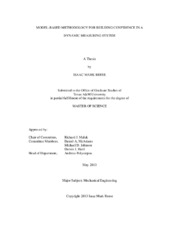| dc.description.abstract | This thesis examines the special case in which a newly developed dynamic measurement system must be characterized when an accepted standard qualification procedure does not yet exist. In order to characterize this type of system, both physical experimentation and computational simulation methods will be used to build trust in this measurement system. This process of establishing credibility will be presented in the form of a proposed methodology.
This proposed methodology will utilize verification and validation methods that apply within the simulation community as the foundation for this multi-faceted approach. The methodology will establish the relationships between four key elements: physical experimentation, conceptual modeling, computational simulations, and data processing. The combination of these activities will provide a comprehensive characterization study of the system.
In order to illustrate the methodology, a case study was performed on a dynamic force measurement system owned by Sandia National Laboratories. This system was designed to measure the force required to pull a specimen to failure in tension at a user-input velocity. The results of the case study found that there was a significant measurement error occurring as the pull event involved large break loads and high velocities. 100 pull events were recorded using an experimental test assembly. The highest load conditions discovered a force measurement error of over 100%. Using computational simulations, this measurement error was reduced to less than 10%. These simulations were designed to account for the inertial effects that skew the piezoelectric load cells. This thesis displays the raw data and the corrected data for five different pull settings. The simulations designed using the methodology significantly reduced the error in all five pull settings.
In addition to the force analysis, the simulations provide insight into the complete system performance. This includes the analysis of the maximum system velocity as well as the analysis of several proposed design changes. The findings suggest that the dynamic measurement system has a maximum velocity of 28 fps, and that this maximum velocity is unaffected by the track length or the mass of the moving carriage. | en |


